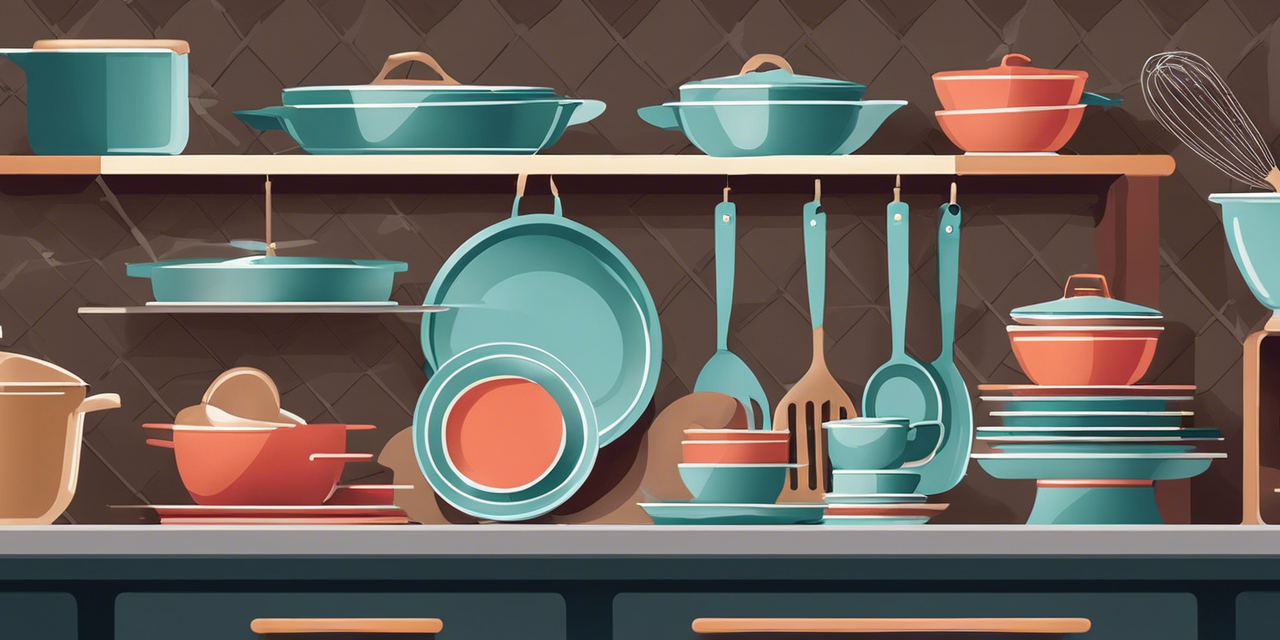Introduction: The Importance of Proper Bakeware Care and Maintenance
Bakeware is an indispensable partner in every kitchen. Its role? Transforming basic ingredients into mouth-watering delicacies. Not surprising that taking good care of these essential tools is crucial. Proper bakeware care and maintenance ensures the longevity of these utensils and their optimal performance.
Beyond cleanliness, maintaining your bakeware impacts its efficiency. But, there's more to the story. Maintaining your bakeware guarantees food safety, improved baking results, and in the long run – savings. Why? You won't have to regularly replace damaged or worn-out bakeware.
Comprehensive Guide on Cleaning Various Bakeware Materials
Cleaning your bakeware is not as straightforward as one might think. Different materials call for specific cleaning methods. Here, we'll break down how to clean various types of bakeware:
-
Non-stick Bakeware: For this type of bakeware, hand wash with a mild detergent and a soft sponge or cloth. It's crucial to avoid abrasive materials, as these could scratch the non-stick surface.
-
Glass Bakeware: Even though most glass bakeware is dishwasher-safe, hand washing is the safest bet. Use a non-abrasive sponge or cloth to ensure its longevity.
-
Aluminium Bakeware: Aluminium bakeware calls for a gentle approach. Hand wash it using a gentle detergent and a non-abrasive sponge. Steer clear of robust chemicals and rough scrubbers that could damage the surface.
- Silicone Bakeware: Celebrated for its non-stick properties, silicone bakeware is simple to clean. Whether you opt for hand washing or a dishwasher, use gentle detergent and a sponge.
Remember, thorough cleaning after each use gets rid of stubborn food residue and prevents bacteria growth, ensuring food safety.
Proper cleaning is a crucial part of bakeware care and maintenance. It enhances heat distribution during baking, resulting in perfect results every time. Plus, it preserves the non-stick properties of your bakeware, ensuring easy food release.
Comprehensive Guide on Cleaning Various Bakeware Materials
A significant aspect of bakeware care and maintenance is understanding how to clean different bakeware materials properly. The cleaning method varies depending on the bakeware material, and using the right one will prevent damage and prolong the lifespan of your bakeware. Here's how you should care for a range of bakeware materials:
-
Non-stick Bakeware: Non-stick bakeware should be hand washed with gentle dish soap and a soft sponge or cloth. It's crucial to avoid harsh scrubbing materials that could scratch the non-stick surface.
-
Glass Bakeware: Although glass bakeware can be cleaned in a dishwasher, the longevity of the material is better preserved when it's hand washed with a non-abrasive sponge or cloth.
-
Aluminium Bakeware: Aluminium bakeware should be hand washed with a mild dish soap and a non-abrasive sponge. Steer clear of strong chemicals or rough scrubbers that could damage the surface.
- Silicone Bakeware: Silicone bakeware, celebrated for its non-stick qualities, can be easily cleaned by hand or in the dishwasher. When cleaning by hand, it's best to use a soft sponge and gentle dish soap.
Key Takeaway: Adhering to the specific
cleaning guidelinesfor different bakeware materials is crucial in maintaining their longevity and functionality. Regular cleaning not only keeps your bakeware in top condition but also enhances food safety by eliminating food residue and bacteria growth.
| Bakeware Material | Cleaning Method | Tips |
|---|---|---|
| Non-stick | Hand wash with gentle dish soap and sponge | Avoid harsh scrubbing materials |
| Glass | Hand wash/ dishwasher safe | Hand washing recommended for longevity |
| Aluminium | Hand wash with mild dish soap and sponge | Avoid strong chemicals or rough scrubbers |
| Silicone | Hand wash/ dishwasher safe | Use a soft sponge and gentle dish soap when cleaning by hand |
Remember, the care and maintenance of your bakeware extends beyond just cleaning. It also involves appropriate storage techniques, which we will delve into in the next section.
Innovative Bakeware Organizing and Storing Techniques
Post-cleaning, the way you organize and store your bakeware can significantly influence its longevity and performance. Here are some innovative techniques to consider for efficient bakeware organization and storage:
Organizing Your Bakeware
-
Drawer or Cupboard Dividers: Utilize dividers within your drawers or cupboards, which help keep your bakeware separate, preventing scratches or clattering. This also simplifies the process of locating the bakeware you need.
-
Lid and Tray Organisers: Employ lid and tray organizers to systematically store your baking trays, pans, and matching lids, ensuring they're easily accessible and neatly arranged.
Proper Storage Techniques
Correct storage practices safeguard your bakeware from potential damage while helping maintain its shape.
-
Stacking: When stacking bakeware, introducing a protective layer, such as a tea towel or silicone mat between each piece, helps prevent scratches or chipping.
-
Hanging: If your kitchen is limited on cupboard space, hanging your bakeware on a wall or inside a cupboard door using hooks or a wall-mounted rack can be an excellent storage solution.
Key Takeaway: Innovative and thoughtful bakeware organizing and storing techniques are key to
bakeware care and maintenance. These practices are instrumental in preserving your bakeware’s structural integrity and functionality over time.
| Bakeware Storage Technique | Description |
|---|---|
| Drawer or Cupboard Dividers | Separate bakeware to prevent scratches and clattering while enabling easy location of bakeware |
| Lid and Tray Organisers | Keep trays, pans and matching lids neatly stacked and accessible |
| Stacking | Place a protective layer between each piece to prevent scratches or chipping. Stack from largest to smallest. |
| Hanging | Hang bakeware using hooks or wall-mounted racks. Ideal for kitchens short on cupboard space. |
With these storage tips in mind, let's dive deeper into the exact cleaning and storing methods to ensure superior bakeware performance, which will be covered in the next section.
Detailed Cleaning and Storing Methods for Enhanced Performance
For optimal performance and longevity, bakeware requires diligent and effective care and maintenance practices. Beyond the general cleaning and storing guidelines, let's examine elaborate cleaning techniques and storage solutions for your bakeware.
Effective Hand Washing Approach
Hand washing your bakeware allows for careful handling, reducing the risk of damage. To achieve efficient hand washing:
- Fill your sink or basin with warm water and add a few drops of dishwashing liquid.
- Immerse your bakeware in the soapy water and gently scrub away food residue with a non-abrasive sponge or cloth.
- Dedicate attention to corners and crevices, where stubborn residue may be hiding.
- Rinse your bakeware thoroughly with warm water to discard any soap residue.
- Dry your bakeware with a clean tea towel or let it air dry completely before storing.
Dishwasher Safety
While some bakeware is labeled as dishwasher safe, always seek confirmation from the manufacturer's instructions before placing them in the dishwasher. Here are some guidelines:
- Non-stick Bakeware: Though most non-stick bakeware is dishwasher safe, hand washing is recommended to extend their lifespan.
- Glass Bakeware: Glass bakeware can typically withstand dishwasher cleaning. However, be wary of intense temperature fluctuations that could lead to cracking.
- Aluminium Bakeware: Aluminium bakeware should ideally avoid dishwasher use, as harsh detergents and high heat can result in discoloration or damage.
Bakeware Storage Solutions
Storage solutions like stacking and hanging can help maximize kitchen space while caring for your bakeware.
Stackable Solutions
Stacking bakeware demands safety precautions:
- Ensure your bakeware is thoroughly dry after washing.
- Introduce a protective layer between each piece, such as a tea towel or silicone mat, to prevent scratching.
- Stack the bakeware from largest to smallest, positioning the heaviest items at the bottom.
- Avoid stacking too many pieces to protect the bottom items from excessive weight.
Hanging and Displaying Options
If your kitchen is spacious, consider hanging or displaying your bakeware.
- Wall-Mounted Racks: Install a rack designed for bakeware storage. It provides easy access and lends aesthetic appeal to your kitchen.
- Cupboard Doors: Maximize space by hanging your bakeware on the inside of cupboard doors using hooks or racks.
Key Takeaway: Detailed and meticulous cleaning and storing methods can substantially enhance bakeware longevity and performance, significantly contributing to bakeware care and maintenance.
In the upcoming section, we'll see how these practices lead to improved baking experiences and bakeware longevity.
Conclusion: Embracing Bakeware Care for Improved Baking Experiences and Longevity
Implementing the right bakeware care and maintenance strategies yields benefits that extend beyond simply keeping your baking tools clean and organized. By adhering to these practices, you can improve your baking experiences and prolong the lifespan of your bakeware.
Advantages of Proper Bakeware Care and Maintenance
-
Extended Bakeware Lifespan: By following the recommended cleaning and storage practices, you can significantly enhance the lifespan of your bakeware. This not only reduces the replacement frequency of worn-out or damaged pieces but also saves you money in the long run.
-
Food Safety Assurance: Thorough cleaning post each use eliminates food residue, preventing harmful bacterial or mold growth. This practice ensures the health safety of the food you prepare.
-
Optimized Baking Results: Well-maintained bakeware contributes to better baking outcomes. Clean bakeware ensures even heat distribution, resulting in perfectly baked goods each time. Further, avoiding scratches and damage maintains the non-stick attributes of your bakeware, ensuring easy food release.
Key Takeaway: Outlining the importance of these practices in bakeware care and maintenance, we can conclude that their effective implementation is essential for achieving optimal baking results and prolonged bakeware life.
| Bakeware Care Benefits | Description |
|---|---|
| Extended Lifespan | Prolongs bakeware usage life, saving you money in the long run |
| Food Safety | Ensures the safety of the food you prepare by eliminating food residue and preventing bacteria growth |
| Optimized Baking | Contributes to better baking outcomes through even heat distribution and maintaining non-stick properties |
Through this comprehensive guide, it's clear that caring for your bakeware is not just about cleanliness but a measure to ensure its optimal functionality that impacts your overall baking experience. Always remember – a little maintenance goes a long way in serving you scrumptious treats for years!





